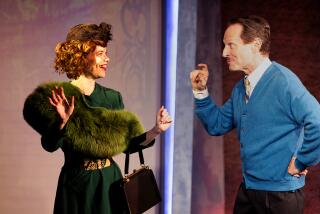A way back to freedom
- Share via
Superbly danced by the Hamburg Ballet, John Neumeier’s two-act “Death in Venice” boldly updates the story and subverts the central issues in the celebrated 1912 Thomas Mann novella of the same name.
Set to mostly recorded music by Bach (sometimes jazz or rock transcriptions) and Wagner (sometimes live piano reductions), this surprisingly personal, stream-of-consciousness dance drama from 2003 came to the Orange County Performing Arts Center on Saturday as evidence of the large-scale creative experiments that European ballet companies continue to offer their audiences but that haven’t been consistently attempted in this country for the last quarter of a century.
Neumeier adopts Mann’s narrative structure, yet doesn’t show us a writer in his 50s paralyzed by desire for a virginal boy he sees but never really meets on a trip to Italy. Instead, Gustav von Aschenbach is now a renowned ballet choreographer who looks to be in his mid- to late 30s, while his elusive Tadzio is no innocent 14-year-old but rather a strapping twentysomething with muscles to die for (which is pretty much what happens).
In Mann’s novella, a relationship between Aschenbach and Tadzio is impossible (not to mention immoral and illegal). But in the contemporary ballet world, where Neumeier’s “Death in Venice” takes place, the example of impresario Sergei Diaghilev and his young proteges -- or, more recently, of choreographer Frederick Ashton and his so-called secret muses -- might well give this Aschenbach hope for consummation.
So, what accounts for the deep, hopeless yearning at the core of the ballet -- and at the heart of Lloyd Riggins’ magnificent performance as Aschenbach? More than mere lust or longing for an Apollonian ideal, it comes from a sense of artistic displacement.
Aschenbach has reached a dead end in rehearsals for a new ballet and suddenly finds in Tadzio and his young friends the way back to a realm of free, integrated, spontaneous movement. Flashbacks tell us that Aschenbach once belonged to that realm, and his increasingly desperate attempts at reentry keep him in Venice, stalking Tadzio -- trying to become Tadzio -- even when a plague arrives.
The ending becomes an agonized Wagnerian love-death duet, with pianist Elizabeth Cooper more intense than “mild und leise” in her interpretation of Isolde’s lament and designer Peter Schmidt’s mobile scenic panels dissolving into a vision of an endless sea. Aschenbach feverishly winds himself around Tadzio here, seeking -- what? -- a kind of fusion, perhaps. But the need is way, way beyond sexual, and Riggins almost makes us see his soul passing out of his body.
As always, Neumeier proves endlessly resourceful in depicting the interplay of fantasy and reality. He can stop time to show us a full-scale duet developing in Von Aschenbach’s mind during the brief moment when he falls on the beach and Tadzio helps him up. But no choreographer, living or dead, could be equally successful in depicting Aschenbach’s constricted classicism, the pain of his isolation, his passion for Tadzio (or what he represents), the boys’ beach games, the elegant social rituals of the hotel guests and the neo-Expressionist action-paintings of sex and death.
Apart from the listless corps passages at the hotel, the green-tinged orgy nightmare may be the work’s weakest sequence -- although inside it is a terrific trio for Aschenbach and his two devilish, omnipresent tempters (Otto Bubenicek and Amilcar Moret Gonzalez).
The extended ballet rehearsals are more strongly etched and feature the heroic Ivan Urban, along with such Hamburg paragons as Silvia Azzoni, Alexandre Riabko and Helene Bouchet. They later return as phantoms, as do Laura Cazzaniga (in multiple roles) and Konstantin Tselikov (as a younger, high-spirited Aschenbach).
Yohan Stegli brings youthful bravado and perfect technique to the beach scenes -- although they, of course, belong to Tadzio: the tall, refreshingly uninhibited and sometimes even gawky Edvin Revazov, not so much an icon of the form divine as Neumeier’s living reminder that natural, authentic human motion always belongs at the epicenter of classical dance.
More to Read
The biggest entertainment stories
Get our big stories about Hollywood, film, television, music, arts, culture and more right in your inbox as soon as they publish.
You may occasionally receive promotional content from the Los Angeles Times.










